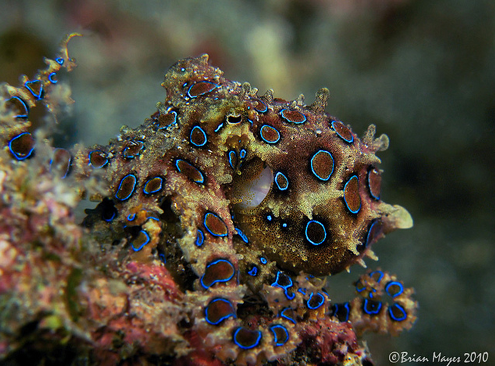Habitat
Given how unique the Hapalochlaena lunulata is, one might suspect that this species of octopus is not widely spread out geographically.
The truth is that this octopus has been sighted in many different places within the Indian and Pacific Oceans of the world (Death in a Pretty Package). They are most common in the the shores around northern Australia, but they have been spotted as far away from Australia as Sri Lanka (Bartick).
The Greater Blue Ringed Octopus tends to live in shallow marine locations such as coral reefs and tide pools (Aquarium of the Pacific). Their small size makes them quite vulnerable in deeper, more open areas of the sea, poisonous or not (Encyclopedia of Life).
They have quite vulnerable bodies, so when they are not hunting or searching for a mates, they spend their time hiding in whatever enclosed space they can fit into, which, as octopuses, means they can hide just about anywhere (Encyclopedia of Life). In fact, they rarely leave their nests at all and leave only if necessary or if a better location is available (Encyclopedia of life). As a result, it is not easy to find this species of octopus, even with their unique coloring (Cl@ssmate). Their nature as bottom feeders means that they stay close to the ground when out on a hunt as a method of preventing harm from coming to them (Aquarium of the Pacific). In this case, they actively dig up any prey from below the soil (Encyclopedia of Life). Rarely, they can chase an amphibious animal out of the water in order to eat although it does leave them at risk for suffocation (Encyclopedia of life).
The shallow areas of the ocean this species lives in are often visited by beach-goers and divers and reports of tourists being poisoned by this difficult-to-see cephalopod occur every year (Death in a Pretty Package). An unwary diver can very easily agitate the octopus completely by accident (Cl@ssmate). Of course, it must be taken into account that, despite being one of the deadliest octopuses alive, human mortality from the species is very low (Boyer).
To learn more about the greater blue-ringed octopus and its general form and how it functions, please go to the next page.

